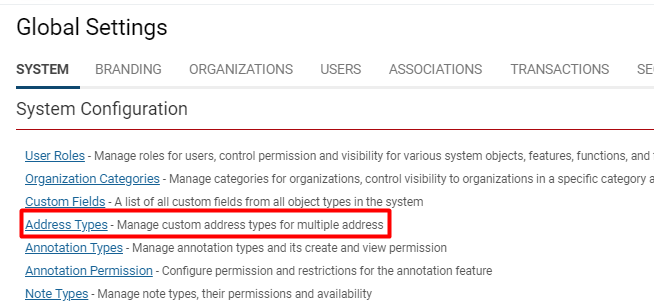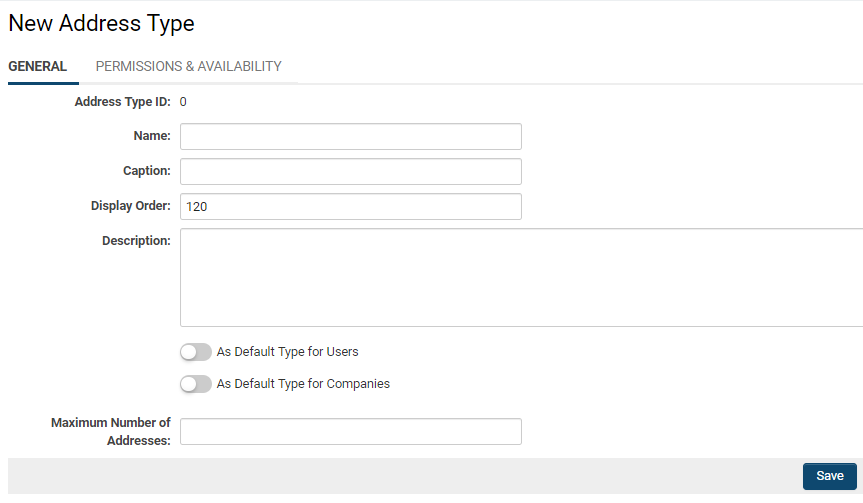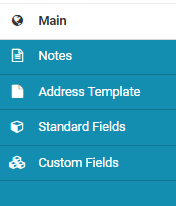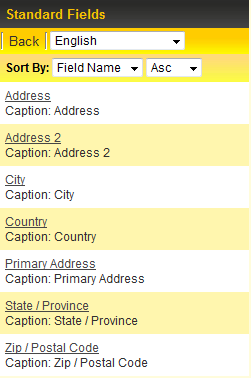Address Types
Contents
Overview
The Address Types setting allows you to define a number of different address types to be used elsewhere in the system.
Configuration - Essentials
Example of Address Type
Address Types are available to a user with a role that an Address Type has been made available to; similarly, they are available to an organization with a category that an Address Type has been made available to.
When accessing the profile of a user or organization, viewing their address details will reveal the relevant Address Type. If you are in the System Administrator role, you will also have the ability to modify the Address Type from the profile.
Accessing Address Types
In order to use this feature, follow these steps:
1. Click on the 9-square menu icon on the top right of your page.
2. Under the heading Configuration, select Global Settings.
3. Under the first tab, select Address Types.
The list of available Address Types will be displayed. If there are none in the system, this page will be blank. You can create and configure new Address Types by selecting the + icon on the top left of your page. You can edit existing Address Types by selecting the pencil icon on the left of each Type name.
Manually Creating a New Address Type
To create a new Address Type manually, after clicking the + icon from the Address Types page, you must fill in the fields for the new type.
| Name | Text used to identify an address type |
| Caption | Normally the same as Name, unless you want to add a label for the address type that is different |
| Display Order | Address types will be displayed in the drop-down with regards to the display order, with the lowest value of display order appearing first in the drop-down list. |
| Description | A general description for the address type |
| Colour Code | An optional colour code for the address type when displayed |
| Default Type |
In order to use the Multiple Addresses feature, a default address must be selected.
Note: Enabling either of these will make all roles (for Users) and all categories (for Companies) have access to this Address Type. |
| Maximum Number of Addresses | The maximum quantity of this specific type of address allowed. |
If a Default Type is not set on an Address Type - either for Users or Companies - the combo box for Address Types will not be displayed when adding/editing an address record.
Click Save once you are done filling out the fields, and click onto the second tab, Permissions and Availability.
Click into each text box to select which statuses, roles, and categories will have access to this Address Type from within their user or company profile. Depending on whether you have enabled the Address Type as a default for Users or Categories, you will not have the option to select specific roles or categories - instead, the default function makes this Address Type available to all.
Once the fields are populated as required, click Save.
The details of the new Address Type will display on a new page, indicating that it is now available on the list of Address Types available in your SmartSimple instance.
On the left hand side, the menu items related to Address Types will be displayed:
| Main |
The General tab displays the descriptive information related to the Address Type:
The second Permissions & Availability tab denotes the roles, statuses, and categories able to access this Address Type. |
| Notes | You can create, edit and view notes attached to this Address Type. |
| Address Template | You can create, edit and view the address template associated with this Address Type. The address template is a feature used to personalize the block of text that is returned when using the @addressbobok@ variable. See the Address Book Template page for configuration instructions. |
| Standard Fields | Learn how to add Standard Fields to Address Type. |
| Custom Fields | Learn how to add Custom Fields to Address Type. |
Importing Address Types
On the main Address Types page, you have the options to either import new records as Address Types into the system, or export the existing Address Types.
Exporting Address Types
In order to use this feature, you must first go to Global Settings > System and check off the "Enable Multiple Address" option.
- IMPORTANT: when enabling you must follow the instructions on the Importing Address Wiki article to ensure the existing addresses are retained. If the Enable Multiple Address option is turned on without importing addresses from existing profiles or loading a new set of addresses, whenever a new address is added to a profile, the original data stored in the profile address will be lost
Configuration - Advanced
Add Custom Fields to Address Type
- Click on the Fields button to the right of the Address Type name you wish to add custom fields against.
- Click on the New Field tab at the top of the screen.
- The New Custom Field window is displayed, with existing options for configuring required custom fields. See Custom Fields – General Information for further details.
Add Standard Fields to Address Type
- Click on the name of the Address Type as displayed in the Name column.
- Click on the Standard Fields tab at the top of the screen.
- User is presented with a list of available Standard fields.
- Click on the hyperlink for a standard field and configure the visibility and validation that you wish to apply for that specific field.
- Click Save
Referencing Address Types
- The @primaryaddress@ and @addressbook@ variables can be used to reference addresses when multiple address types are enabled. See Address Book Template for more information.
- Individual Address Type values can be referenced using the list syntax [#(?object=address) ... #] under a user or company.








